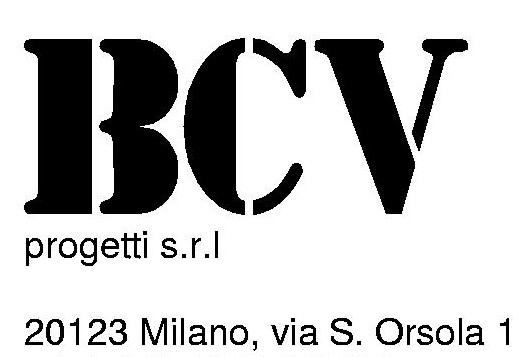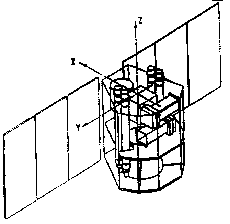
SAX Mission
SAX, acronym for "Satellite for Astronomy in X-Rays", identifies a project of the Italian Space Agency (ASI) in collaboration with the Netherlands Agency for Aerospace Programs (NIVR), with the partecipation of the Space Research Institute of Utrecht, the Space Science Department of Europen Space Agency (ESA) and the Max Plank Insitute of Munchen.
SAX Satellite
The project, the first Italian scientific mission in the field of the X-Ray astronomy, has been submitted by a consortium of Italian and Dutch research institutes, in 1981 to Piano Spaziale Nazionale (PSN, now ASI) of Consiglio Nazionale delle Ricerche (CNR).
SAX will be devoted to systematic, integrated and comprehensive studies of galactic and extragalactic sources in the band 0.1-200 keV.
The satellite has been successfully launched in 1996.
It started its scientific mission after the instrument calibration phase and it is now (1997) fully active.
Prime contractor of the SAX program is ALENIA (ex AERITALIA), while the developing of the scientific payload is in charge to LABEN.
The scientific payload consists of three narrow field instruments (NFI) and two wide field cameras (WFC).
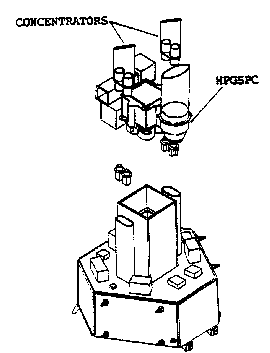
The NFIs consist of three units of Medium Energy Concentrators Spectrometers (MECS), one unit of Low Energy Concentrators Spectrometers (LECS), one High Pressure Gas Scintillation Proportional Counter (HPGSPC) and one Plasmic Detector System (PDS).
The concentrator Mirror assemblies, that are part of the MECS and LECS instruments, and the HPGSPC have required a detailed study phase, expecially from a technological point of view, in order to guarantee the expected scientific performances.
Scientific payload of SAX satellite
BCV has been involved in the design, analysis and testing relevant to the following components of the MECS and HPGSPC instruments.
- Mirror Shells
- Mirror Module
- HPGSPC Beryllium Window
- HPGSPC Titanium Frame for Laboratory Prototype Model.
SAX Mission: Mirror Shell and Mirror Module
Our activity started in 1985, committed by CNR-Istituto di Fisica Cosmica (Milano), with the preliminary static and dynamic analyses on the mirror shells in order to define thicknesses and support point number fulfilling structural requirements.
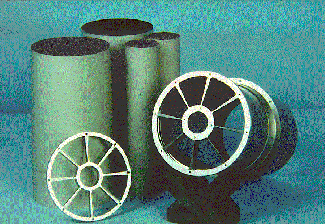
The activity continued in 1987 with the structural design of the Mirror Module and its main components (spokes, interface flanges etc.).
At the same time the first vibrational test started, performed by means of holographic interferometry at CISE laboratories, that confirmed our numerical results.
Finally in 1990 we performed the final structural design of the Mirror Module and of the Mirror Shells, including numerical checks in quasi-static conditions, dynamic behaviour and random vibration analysis.
Some mirror shells and the spiders. Shell diameters vary from 68 to 162mm. Their length is 310mm and thicknesses vary from 0.2 to 0.4mm.
Numerical random vibration results have been confirmed by means of experimental proofs carried out at ISMES laboratories (Bergamo).
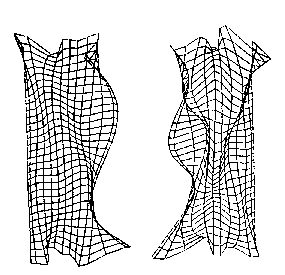
Structural analysis have been carried out by means of general purpose codes SAP V and ADINA.
During these activities we worked out post-processing of structural codes in order to permit or to simplify the interpretation of numerical results.
The numerical results relative to the eigenmodes have been checked and confirmed by means of experimental tests performed at CISE laboratories using holography.
Eigenmodes of one mirror shell.
SAX Mission: HPGSPC Beryllium Window
These analyses have been commited us by CNR-Istituto di Fisica Cosmica ed Applicazioni dell'Informatica (IFCAI Palermo). We started our work in 1988. Our task was to check and to improve static performances of previous design of this component composed by an eggcrated beryllium plate mounted on a titanium flange. The outer diameter of the window is 350mm.
The structural optimization must realize a trade-off between the following contrasting requirements:
-
Maximum X-Rays trasparency, so minimum thickness of the structural elements.
-
Minimum dead weight.
-
High strength to pressure loading.
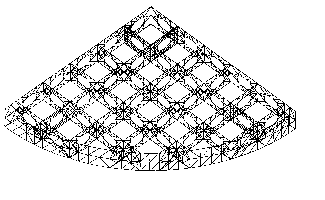
The window has to sustain 5 atm. differential pressure (more than 48 kN resultant load) with a safety coefficient 1.2 respect to the yielding at launching condition and 1.5 respect to the failure on ground.
Refined static analyses of the original and modified design have been performed by means of numerical FE model of the whole structure and by means of local models of the most delicate zones in order to compute the Stress Concentration Factors.
The need to compute yielding and ultimate load required also non linear analyses.
Mesh of the beryllium ribbed core.It is connected to the two beryllium faceplates by brazed joints.
We optimized structural design in order to improve static performance. The mass of the final design is 0.54 kg for the beryllium windows and 3.7kg for the titanium flange that had to mantain the original design due to interface with the other structures.
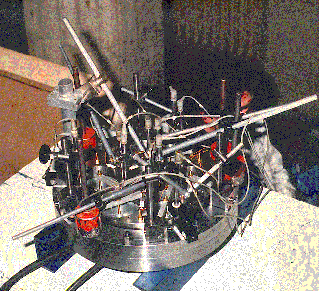
In september 1989 a first window, realized following our new design, has been tested at ISMES by means of static load test. BCV planned and followed directly the tests. Experimental results confirmed the numerical ones.
In april 1991 another identical window has been submitted to more severe tests by AEG and DORNIER. BCV partecipate to the test planning and execution. The following tests have been performed:
-
Holographic picture under static loads.
-
Vibration test (sine resonance search and random vibrations).
-
Pressure test first at the service loads, then at the yielding load and finally at load level very near to the theoretical ultimate one.
No failure occurs during tests, also under loads equal to 7.5 atm very near to the computed ultimate load.
Be window during proofs at ISMES (BG)
SAX Mission: HPGSPC Titanium Frame
Also these analyses have been committed by CNR-Istituto di Fisica Cosmica ed Applicazioni dell'Informatica (IFCAI Palermo).
The goal of our work has been to modify very quickly a previous design, already carried out, in order to appoint a Laboratory Prototype Model.
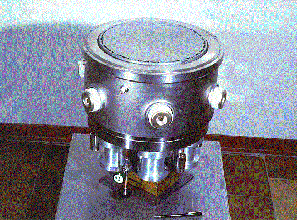
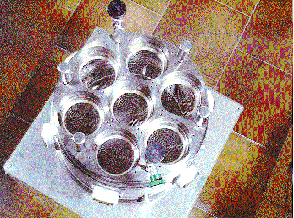
Two views of the High Pressure Gas Scintillation Proportional Counter. Respectively relative to the Beryllium Window side and Titanium Frame side. From the structural point of view HPGSPC is a pressurized cylinder 250 mm high having diameter 350 mm.
Since the short time and since it was a question of Laboratory Prototype (the dead weigth was not so important), no numerical and refined analyses have been performed but an engineerical approach has been used in order to strengthen the existent Prototype.
The final structure has been experimentally tested at ISMES laboratories by means of static load test. The concepts used in our first quick study have been developed and refined in the final design performed by AEG that, by means of numerical analyses, optimized the design in order to reduce the dead weight.
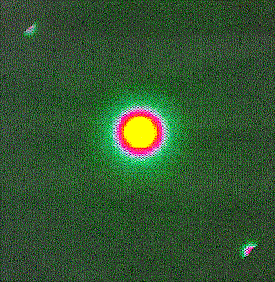
24 June 1996: the first light of SAX MECS2. The very bright central source is Cyg X-1.
